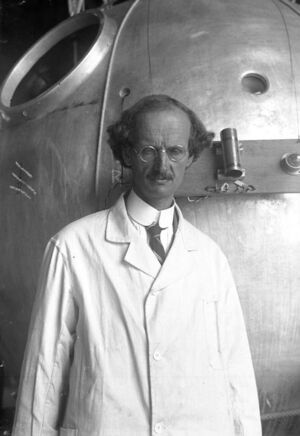Auguste Piccard (nonfiction): Difference between revisions
No edit summary |
No edit summary |
||
| Line 34: | Line 34: | ||
* [[Physics (nonfiction)]] | * [[Physics (nonfiction)]] | ||
External links | == External links == | ||
* [https://en.wikipedia.org/wiki/Auguste_Piccard August Piccard] @ Wikipedia | * [https://en.wikipedia.org/wiki/Auguste_Piccard August Piccard] @ Wikipedia | ||
[[Category:Nonfiction (nonfiction)]] | [[Category:Nonfiction (nonfiction)]] | ||
[[Category: | [[Category:Explorers (nonfiction)]] | ||
[[Category:Inventors (nonfiction)]] | [[Category:Inventors (nonfiction)]] | ||
[[Category:People (nonfiction)]] | [[Category:People (nonfiction)]] | ||
[[Category:Physicists (nonfiction)]] | [[Category:Physicists (nonfiction)]] | ||
[[Category:Scientists (nonfiction)]] | |||
Latest revision as of 11:09, 16 November 2021
Auguste Antoine Piccard (28 January 1884 – 24 March 1962) was a Swiss physicist, inventor and explorer, known for his record-breaking hot air balloon flights, with which he studied Earth's upper atmosphere and cosmic rays, and for his invention of the first bathyscaphe, FNRS-2, with which he made a number of unmanned dives in 1948 to explore the ocean's depths.
Piccard's twin brother Jean Felix Piccard is also a notable figure in the annals of science and exploration, as are a number of their relatives, including Jacques Piccard, Bertrand Piccard, Jeannette Piccard and Don Piccard.
Piccard and his twin brother Jean Felix Piccard were born in Basel, Switzerland on 28 January 1884.
Showing an intense interest in science as a child, he attended the Swiss Federal Institute of Technology (ETH) in Zurich, and became a professor of physics in Brussels at the Free University of Brussels in 1922, the same year his son Jacques Piccard was born. He was a member of the Solvay Congress of 1922, 1924, 1927, 1930 and 1933.
In 1930, an interest in ballooning, and a curiosity about the upper atmosphere led him to design a spherical, pressurized aluminum gondola that would allow ascent to great altitude without requiring a pressure suit. Supported by the Belgian Fonds National de la Recherche Scientifique (FNRS) Piccard constructed his gondola.
An important motivation for his research in the upper atmosphere were measurements of cosmic radiation, which were supposed to give experimental evidence for the theories of Albert Einstein, whom Piccard knew from the Solvay conferences and who was a fellow alumnus of ETH.
On 27 May 1931, Auguste Piccard and Paul Kipfer took off from Augsburg, Germany, and reached a record altitude of 15,781 m (51,775 ft). (FAI Record File Number 10634) During this flight, Piccard was able to gather substantial data on the upper atmosphere, as well as measure cosmic rays.
An article in the August 1931 Popular Science in described their journey:
"The story of their adventure surpasses fiction. During the ascent, the aluminum ball began to leak. They plugged it desperately with vaseline and cotton waste, stopping the leak. In the first half hour, the balloon shot upward nine miles. Through portholes, the observers saw the earth through copper-colored, then bluish, haze. It seemed a flat disk with upturned edge. At the ten mile level the sky appeared a deep, dark blue. With observations complete, the observers tried to descend, but couldn't. While their oxygen tanks emptied, they floated aimlessly over Germany, Austria, and Italy. Cool evening air contracted the balloon's gas and brought them down on a glacier near Ober-Gurgl, Austria, with one hour's supply of oxygen to spare". Popular Science, August 1931 p.23.
On 18 August 1932, launched from Dübendorf, Switzerland, Piccard and Max Cosyns made a second record-breaking ascent to 16,201 m (53,153 ft). (FAI Record File Number 6590) He ultimately made a total of twenty-seven balloon flights, setting a final record of 23,000 m (75,459 ft).
In the mid-1930s, Piccard's interests shifted when he realized that a modification of his high-altitude balloon cockpit would allow descent into the deep ocean. By 1937, he had designed the bathyscaphe, a small steel gondola built to withstand great external pressure. Construction began, but was interrupted by the outbreak of World War II. Resuming work in 1945, he completed the bubble-shaped cockpit that maintained normal air pressure for a person inside the capsule even as the water pressure outside increased to over 46 MPa (6,700 psi). Above the heavy steel capsule, a large flotation tank was attached and filled with a low density liquid for buoyancy. Liquids are relatively incompressible and can provide buoyancy that does not change as the pressure increases. And so, the huge tank was filled with gasoline, not as a fuel, but as flotation. To make the now floating craft sink, tons of iron were attached to the float with a release mechanism to allow resurfacing. This craft was named FNRS-2 and made a number of unmanned dives in 1948 before being given to the French Navy in 1950. There, it was redesigned, and in 1954, it took a man safely down 4,176 m (13,701 ft).
He died on 24 March 1962 of a heart attack at his home in Lausanne, Switzerland, he was 78 years old.
In the News
Fiction cross-reference
Nonfiction cross-reference
External links
- August Piccard @ Wikipedia
